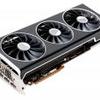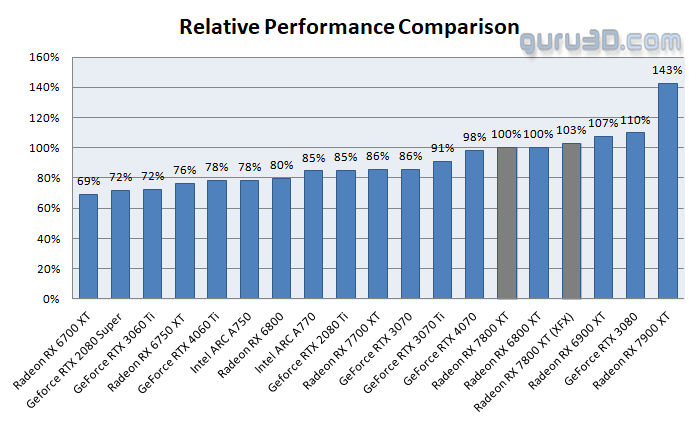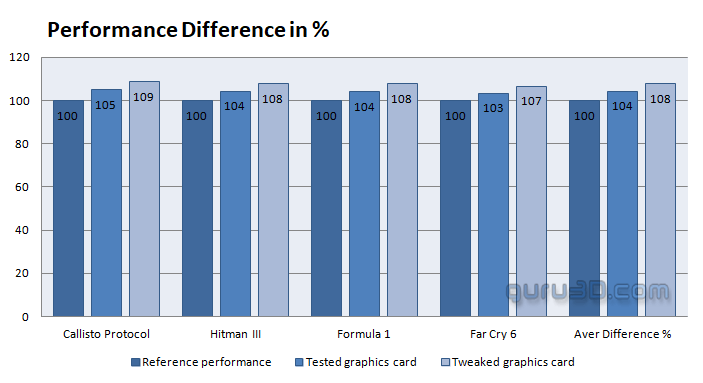Final words and conclusion
Final words
Both the Radeon RX 7700 XT and 7800 XT graphics cards are recent introductions specifically for my favourite monitor resolution, the WQHD monitor range. Both cards feature a notable shader count and VRAM buffers when evaluating their specifications. They are strategically positioned between the GeForce 4060 Ti and RTX 4070, aiming to blend performance and cost-effectiveness. The tested 7800 Xt I do seem to like a notch better overall, and it's just $50 more, so that would be an easy choice for men. The extra VRAM, wider memory bus and 13%-14% extra performance pretty much make the choice a no-brainer. The 7800 XT series does not present groundbreaking technological advancements but brings incremental improvements in raw performance. What I am saying, here is AMD is still a step behind in Raytracing performance and efficient adaptive supersampling techniques with the help of an AI assist. However, most people still do not care about the latter one and as such crave faster shader performance. And here these graphics cards definitely deliver. Notable features include AV1 compatibility, incorporation of the rDNA3 architecture, and updated monitor connectors, all of which enhance the overall user experience but really might not be compelling enough to switch away from NVIDIA. In terms of performance, the RX 7800 XT closely mirrors its 6800XT/6900 XT predecessors within this competitive market segment. Alternatives might offer distinct benefits, so potential buyers should assess their options carefully.
Performance
The 7800 XT graphics cards offer proper rendering quality and capability suitable for mainstream to high-end gaming. Although it doesn't exhibit huge progression from its predecessors (6900 XT), it demonstrates enhanced raytracing performance. Designed primarily for gamers who prioritize a new monitor, the RX 7700 XT and 7800 XT also support QHD monitor resolutions. Within the RX 7000 series, the upgraded rasterizer engine overcomes former performance constraints, highlighting notable raw shader engine capabilities. While NVIDIA's Raytracing and DLSS3 technologies surpass AMD's FSR2 and upcoming FSR3, the RX 7700/7800 XT's performance with FSR2 is still noteworthy, and enabling FSR is recommended. However, based on frametime results, AMD appears to have potential improvements to make at the driver level, as some stuttering was observed.
Cooling & noise levels
Our test shows that gaming will get you an approximate volume level of 37-38 decibels (reference edition), rendering it relatively muffled. Moreover, the graphics card temperature is around 60 degrees Celsius. Furthermore, our utilization of FLIR imaging failed to unveil any worrisome observations.
Energy
The Radeon RX 7800 XT is positioned as a gaming product intended for the high-end market, and it consumes a fair amount of energy. When operating at maximum load, the reference edition draws approximately 250-275 Watts on average (total board power or TBP). This power consumption is directly linked to the amount of heat emitted by the GPU, which is situated within an enclosed casing.
Coil whine
Every graphics card will inevitably produce a discernible buzzing sound known as coil whine when operating at high FPS. Is it bothersome? It becomes noticeable once you push the frame rates to extremely high levels. In a closed computer case, this noise tends to recede into the background. However, when the chassis is open, the coil whine or squeal becomes audible. Almost all graphics cards exhibit this phenomenon to some extent, particularly when operating at higher frame rates. Despite its presence, we have not noticed it enough to be a significant inconvenience.
Pricing
The reference edition comes with a price tag of USD $499, which should be considered substantial for a device primarily used for playing PC games in Quad HD resolution. In the European Union, you must convert the currency and factor in the value-added tax, bringing the total to around 550 euros. Moreover, advanced AIB cards will be even more expensive. In this case, XFX expect 539 USD for the card as tested today meaning this product can end up at 600-650 euros.
Tweaking
The card can be easily tweaked; however, AMD applied maximum values. One beneficial feature is the power limiter, allowing for a wattage increase of up to +15%. This serves as the initial and fastest option for tweaking. Utilizing this option can enhance performance while staying within the card's default power allocation. Additionally, the boost clock frequency can be set at a suitable 2800-2850 MHz, although it may dynamically fluctuate to approximately 2700-2750 MHz due to variations in frequencies across different game titles. Furthermore, the memory can be optimized to operate at around 19 Gbps. When all these adjustments are combined, they result in approximately 4-5% additional performance gains in demanding GPU scenarios, measured relative to the baseline performance. You can add that to the factory tweak, so that's 8-9% additional performance over reference.
To the far right, where you can see "Aver Difference %", this is the result of the four games tested and averaged out.
Conclusion
In the WHQD range, the Radeon RX 7800 XT certainly is a good choice. Of course, depending on budget and needs, the choice can fall either way (7700XT). The 7700 XT, however, at it's reference price of $449 is commendable, and the 7800 XT is preferred, but is priced at $499, remember these are starting prices and AIB product will be roughly $40 more expensive. That said, we had to wait far too long on these new AMD products, in the meantime, NVIDIA already has paved every little gap in the market. Next to that, AMD still does not have a suitable enough answer to their Raytracing performance and DLSS 2/3 and now even 3.5 capabilities. Each brand has its merits, though. By incorporating 64MB of L3 cache, AMD has effectively mitigated the memory bandwidth limitations (256-bit) and ensured suitable performance up to 2560x1440 resolutions. However, it's important to note that the L3 cache functions as a temporary workaround and may not address potential future issues arising from the constrained memory interfaces. Additionally, AMD's raytracing technology might not match the performance of its competitors, but it still offers enough use for a bit of RT-based fun. FSR (FidelityFX Super Resolution) can significantly enhance performance with games that support it. Nonetheless, it's paramount to recognize that "free" performance comes with potential compromises in image quality. Exploring this feature can be an enjoyable endeavour. It's also time for AMD to get FSR3 rolling. The latest indication for FSR3 now is Q1 2024. The Radeon RX 7800 XT series offers a proper QHD gaming experience with its emphasis on rasterized shading, including an additional L3 cache that greatly enhances performance at Full HD and QHD resolutions and CPU-bound games. The elevated asking price remains significant when considering the product's positioning. The products themselves perform well, look nice and remain relatively silent. Energy consumption is on the high side, and slowly but steadily, NVIDIA is advancing much faster concerning Raytracing/Tensor/AI-assisted workloads and solutions for gaming. For their next-gen product, AMD will need to step up on that big time as they're a noteworthy step behind.
The XFX card's transition from the nostalgic THICC naming to the METC SpeedSter 319 reflects a blend of legacy and innovation. The card exhibits distinct design elements reminiscent of its THICC lineage, particularly in its cooler design. This hints at the effectiveness of its three-fan cooling system in managing noise and temperature.While the card boasts factory modifications that give it a slight advantage over the standard reference, the realm of high-end graphics has seen diminishing returns on tweaks. In the past, performance could be boosted by 15% to 20% with adjustments. Today, eking out a 5% to 10% improvement is notable. Given the shrinking scope for enhancement, AIB partners offer products with factory settings that largely mirror each other, diminishing the need for user customization. One of the standout features of the MERC is its robust graphics memory, priming it for future gaming experiences. The promise of playing Ultra HD games without VRAM constraints becomes tangible. Moreover, the Smart Access memory feature enhances this capability. In a comparison with the GeForce RTX 3080/4070, the XFX 7800 XT, equipped with 16GB of graphics memory, holds its ground, especially for users who value aspects beyond Raytracing and DLSS. However, for aficionados yearning for top-tier Hybrid raytracing, AMD's offerings may fall short due to the lack of dedicated hardware Tensor cores and an equivalent to hardware-backed DLSS. The XFX card's price tag of 539 USD could be a point of friction, its performance aligns with key benchmarks in the 6900 range. A pressing concern, however, is its availability and inevitably based on demand, price. Many hope to see these cards become more accessible in the market.
- Download AMD Radeon drivers
- Sign up to receive a notification when we publish a new article.
- Or go back to Guru3D's front page
- Hilbert, LOAD"*",8,1.



